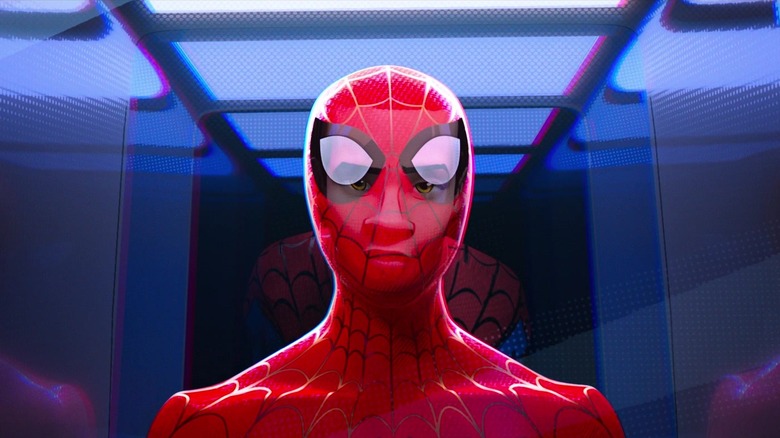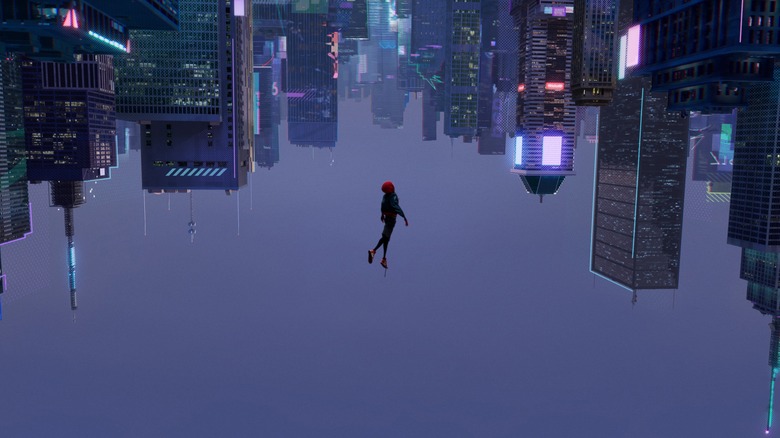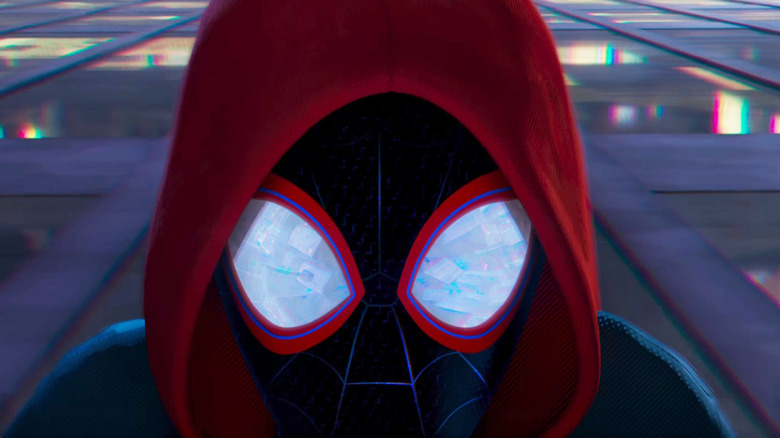The Leap Of Faith In Spider-Man: Into The Spider-Verse Is The Best Action Scene Ever
(Welcome to Best Action Scene Ever, a column dedicated to breaking down the best, most effective action sequences throughout the genre. In this edition, we test the definition of "action" a bit to talk about one of the best superhero scenes of the century: the leap of faith in "Spider-Man: Into the Spider-Verse.")
Who says all action scenes have to fit in the same box? Usually they take the form of standard set pieces, following the time-honored structure you'll find in most screenwriting manuals that carefully parcels such sequences out throughout all three acts before ending on a no-holds-barred climax. But adhering to a strictly procedural understanding of action can't help but miss the entire damn point of this wonderful tool in a storyteller's toolbox. Because the thing about filmmaking is knowing exactly when and where to bend the rules when the story demands it. Call it a leap of faith, if you will.
You want to know why "Spider-Man: Across the Spider-Verse" is currently making it rain at the box office after this past opening weekend? Look no further than 2018's "Into the Spider-Verse," the stunningly rendered animated movie that first introduced us to Shameik Moore's Miles Morales and his multiverse cohorts of Spider-Mans. If it weren't for the careful bricklaying established in the original film, not a single moviegoer turning out in droves to catch his sequel in theaters would even care. And a vast amount of that investment in Miles' journey boils down to one exceptionally thrilling and cathartic moment that, while maybe not a conventional action scene, packs just as much of a visceral punch as any set piece in the film.
The scene
Miles is at his lowest point. While struggling with his relationship with his father Jefferson throughout the story, the true gut-punch arrives when our hero discovers that one of the fearsome villains on his tail for the entire movie — the Prowler — is actually his Uncle Aaron (Mahershala Ali) in disguise. Miles revealing himself as Spider-Man at the last possible moment saves his life ... but only at the cost of his uncle's, as one well-placed bullet from Kingpin's (Liev Schreiber) gun proves the cost of hesitating from finishing the job. A series of emotional lows follow in swift succession, starting with Peter B. Parker (Jake Johnson) and his interdimensional Spider-Pals reluctantly relegating Miles to the sidelines — partly because of his turbulent mental state after narrowly surviving his big origin story moment, but also because of his inability to control his powers.
Then comes the turning point. There's nothing inherently action-y about a dialogue scene between a father and son (especially when that aforementioned son can't even speak, having had his mouth webbed shut by Peter B.), but Jefferson's heartfelt and one-sided conversation with Miles provides the motivation for everything that comes next. After listening to his father reaffirm his love and support for his wayward son, Miles channels every ounce of his inner turmoil into one blast of his venom strike to escape his webbing, turn invisible to evade his roommate's detection, and go along his way. Then comes one of the most finely edited, powerfully moving, and cheer-worthy moments in any superhero movie ever made.
Why it works
One of the biggest misconceptions about action scenes has to do with the idea that audiences need to be shocked and surprised. While there's an element of truth to playing with expectations and keeping viewers on their toes, that runs the risk of missing the forest for the trees. The best action scenes are all about paying off on prior narrative setups — which means properly following through on what the screenplay telegraphed earlier. With the leap of faith in "Spider-Verse," not a single person watching the movie should've been caught unaware that Miles would eventually receive his own comic book cover moment, end up trading his cobbled-together costume for a homemade one, or that Peter B.'s "It's a leap of faith" comment would eventually be taken quite so literally.
But it all works so well precisely because the filmmakers instinctively knew that, of all the scenes in the movie, this was the moment where they couldn't get too cute.
It all feels so obvious the second Black Caviar and Blackway's "What's Up Danger" begins to kick in. After running away from jumping off that skyscraper and instead hilariously taking the stairs in an earlier scene, of course Miles' big coming-of-age moment would require leaping from the highest building in New York City. After failing to measure up to the Spider-suit tucked away in Aunt May's (Lily Tomlin) fancy hideout, of course his drastically improved emotional arc is reflected visually by perfectly matching up the mask with his reflected face in the glass. And after so much emphasis on his graffiti artwork as a way to express himself emotionally, it makes all the sense in the world that he'd pay homage to his Uncle Aaron by spray-painting his new suit.
The key moment
When a scene fires on all cylinders like this one undeniably does, it can be tough to narrow down and target just one specific element that makes it all sing. Is it the voiceovers that turn the subtext into text, allowing us to experience Miles' inner thoughts as he reflects on everything his various mentors — his father, his uncle, Peter B., and many others — have instilled in him? Is it the rapid-fire montage throwing one memorable image at us after another, condensing what could've been a much longer and less well-paced sequence into a perfectly streamlined one? Or is it the sense of genuine comic-book storytelling invading every frame, culminating in the moment when Miles is plunging through the air and the shot suddenly turns into a series of comic book panels straight out of a classic splash page?
There's a certain sense of magic that happens when every aspect of filmmaking comes together in perfect unity to achieve the same goal — especially in an action movie. And if action is about character and story intersecting in a way that only visual storytelling can allow, then I can't think of a more fitting example that of Miles coming into his own as Spider-Man while leaping and swinging his way through the streets of New York City. No, there aren't any prototypical villains in this scene beyond Miles' insecurities, no obstacles in his path other than his emotional hang-ups, and nothing here that really "advances the plot," as too many young moviegoers love to obsess about.
But it's arguably the high peak of either "Spider-Verse" movie to this point and the purest possible expression of character through action. All it took was a leap of faith.


